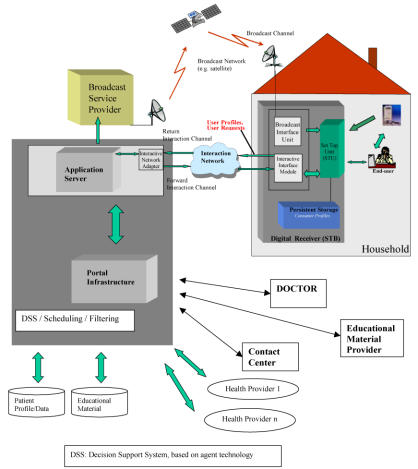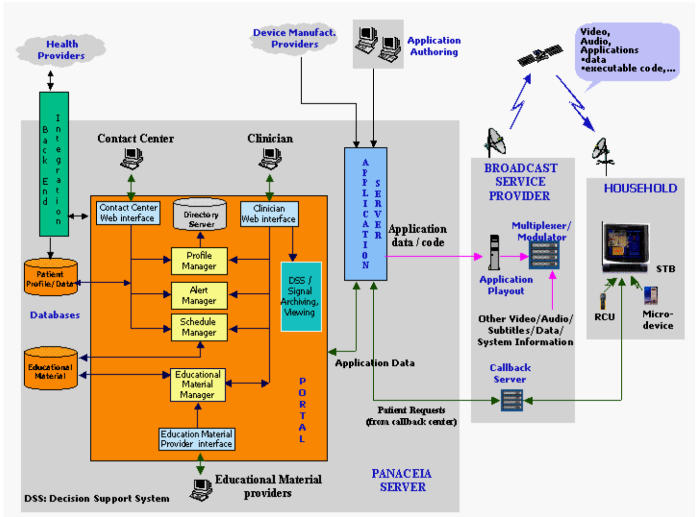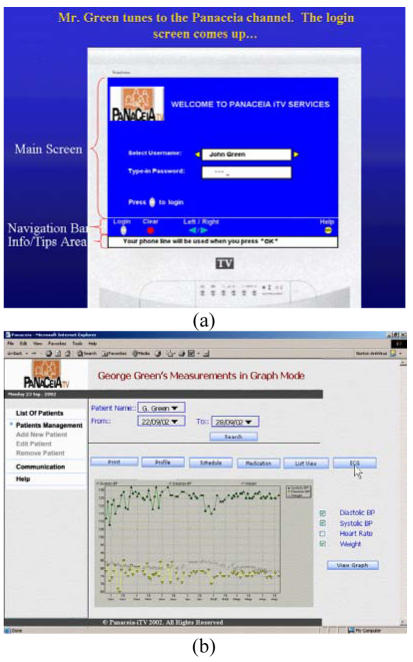Abstract
In the context of an IST European project with acronym PANACEIA-ITV, a home care service provision system is described based on interactive TV technology. The purpose of PANACEIA-ITV is to facilitate essential lifestyle changes and to promote compliance with scientifically sound self-care recommendations, through the application of interactive digital television for family health maintenance. The means to achieve these goals are based on technological, health services and business models. PANACEIA-ITV is looking for communication of monitoring micro-devices with I-TV set-top-boxes using infrared technology, and embodiment of analogous H/W and S/W in the I-TV set-top-boxes. Intelligent agents are used to regulate data flow, and user queries as well as service provisions from and to the household through the satellite digital platform, through portals and through filtering and decision support mechanisms using predominantly the Active Service Provision (ASP) model. Moreover, interactive digital TV services are developed for the delivery of health care in the home care environment.
INTRODUCTION
Information technology (IT) applications in medicine are rapidly expanding, and new methods and solutions are evolving since they are considered pivotal in the success of preventive medicine1. In the past days, IT applications were mainly applied at the secondary health delivery level, and even at specialised hospital departments. These applications were difficult to use, maintain, and they were quite expensive. Today, due to the fast growing and penetration of the INTERNET and mobile telephone technology, the IT applications in the health care environment are focused at e-consultation2 and home care delivery3 and the use of triage systems4. Home care delivery is a very important issue, covering the management of chronic diseases, wellness, education and information delivery on-demand and addressing socially delicate targeted problems such as infertility. Thus, there is a demand for continuous monitoring of basic parameters of the patient, as well as timely delivery of educational material, so as to avoid complications and to prevent the advent of serious diseases. IT-based applications for home care delivery are important media to increase health care quality, increase quality of life and create a better educational platform with carefully designed and customisable patient prompting which in turn is expected to be instrumental in increasing the collaboration degree between the patient and the physician, something which is beneficial to both5,6.
In this paper the use of interactive TV for Citizen Centered Health and Lifestyle Management system is considered, by use of the PANACEIA-ITV paradigm. The main concept is to exploit the Digital ITV advantages for home care services and for increasing health care quality and safety. The technological innovation of the proposed platform resides in the use of DVB-MHP technology for the development of ITV applications and the communication of the Set-Top-Box (STB) with the monitoring medical microdevices using infrared (IR) communication.
METHODS
An overview of the PANACEIA-ITV system is presented in Figure 1. The basic communication means used in the current work are satellite TV for the patient and Internet for the clinician. Patient needs a very simple interface that will guide him/her through the different services provided and will be handled with the remote control. Clinician needs a more sophisticated interface for the monitoring of patients’ condition. At the end users’ environment the Patient’s interface is managed through the STB, which communicates via an IR link with the medical microdevices. The patient is able to interact with the PANACEIA-ITV service provider receiving Educational Videos, Messages and other patient related info, either over satellite transmission or via the Return Channel. Patient Data, entered with a Remote Control Unit and by the medical microdevices, are submitted to the PANACEIA-ITV Server via the Return Channel.
Figure 1.
PANACEIA-ITV system overview.
The Application Server of the architecture is mainly responsible for adapting PANACEIA-ITV to the broadcaster’s environment and to handle Interactive Applications.
The Portal is the principal access point to the system functionalities for all actors. It provides the interfaces needed by those actors in order to perform their tasks. Web interfaces are provided to the Contact Center, the Clinicians and the Educational Material Providers.
Databases exist for storing patients’ profiles and clinical data, educational material related info and also profile info of the rest of the PANACEIA-ITV actors.
In the following sections, the PANACEIA-ITV system is described in more detail from a functional and technical point of view.
A. Scenarios of Use
As far as the target groups are concerned, PANACEIA-ITV starts with specific patient and general population groups, which will define the superset of user requirements and will evaluate the PANACEIA-ITV platform. Four different scenarios of use have been defined, including Diabetes II patients (chronic condition), Congenital Heart Disease patients (chronic condition), Prenatal group-High Risk Pregnancy (general population), Infertility couples (sub acute condition).
Users and Stakeholders have been defined for the system. The Users of the system are Citizens/Patients, Clinicians and Contact Center personnel. The Stakeholders are the Technology Providers, e.g. Broadcaster, Medical Device Manufacturers, Educational Material Providers. In the following, each role is described in more detail.
Citizens/Patients
Users who want to manage their own health and/or need specialized healthcare services.
Users at home may be either patients or healthy people who use the PANACEIA-ITV services such as data exchange, prompting and querying for communicating with the medical professionals through their TV sets and STBs. An important aspect is that users at home are able to receive educational material in the form of tips, digital videos or interactive hypertext.
Clinicians
Doctors & Nurses.
The clinicians are responsible for monitoring their patients’ condition by checking the transmitted measurements and scheduling the patient’s activities and communication protocol via the PANACEIA-ITV system. Using a customized web interface they are able to view the values of the measurements that the patients perform at home, as well as to check whether the patients follow their schedule. Finally, medical staff is responsible for reviewing any educational material submitted for broadcasting.
Contact Center
Provide the communication between the clinicians & the patients/citizens.
The main role of the Contact Center staff is to administrate the PANACEIA-ITV application and specifically all the patients that are registered with the PANACEIA-ITV service, as well as to register new patients and train them. In addition, the Contact Center personnel receives the educational multimedia material from the Educational Material Provider, defines its scheduling and finally delivers it to the broadcaster.
Educational Material Providers
This entity provides the educational material to the PANACEIA-ITV system. The material is in the form of tips, hypertext/images or videos and it is associated with specific patient groups and group categories. This association is defined by the Educational Material Provider.
Broadcaster
This is the owner of the digital broadcasting platform and its role is to receive the content and the digital TV applications and to broadcast them to the households that are registered with the PANACEIA-ITV Service.
Besides the aforementioned functional specifications, there are some general system requirements, including security, multilingual support and possibility for integration with existing systems. The system offers user customization and has event logging capabilities.
B. System Description
PANACEIA-ITV is a multi-component system (Figure 2). Much of its innovation lies in the integration of different modules and technologies, which are described in the following section.
Figure 2.
The PANACEIA-ITV specific architecture.
PANACEIA-ITV Front-End
Patients’ STB receives the broadcasted data (audio/video plus the PANACEIA-ITV application). The STB demultiplexes the incoming transport stream and sends the audio/video to the decoders and executes the application according to the user’s profile. This scheme allows the user to interact with the application and communicate with the PANACEIA-ITV Server (full two-way interaction). Furthermore, it allows IR communication between the STB and the medical microdevices.
The equipment available for the patient will be the STB, the microdevices and the Remote Control. IR communication with the STB is mandatory for signal and vital parameter transmitting microdevices, such as the 12-lead ECG and CTG microdevices.
Broadcaster
The Broadcaster owns bandwidth on a broadband network and possesses the infrastructure for broadcasting. This part is assigned the task to schedule events and allocate bandwidth for their transmission. The event’s video and audio streams are multiplexed with the PANACEIA-ITV application and broadcasted through a broadband network (like cable, satellite or terrestrial) to the users at home.
PANACEIA-ITV Server
It controls and provides communication links between the different PANACEIA-ITV users. Its basic tasks are (a) to regulate the information and request flow using various purpose software agents, (b) to aggregate content and service modules and provide multiple modality access to users, (c) to incorporate the potentially distributed databases holding educational material and citizen/patient data and potentially (d) to deliver the same application on different platforms, through the use of different application servers.
Application Server
The PANACEIA-ITV Application Server, is the component of the PANACEIA back-end, which is aware of the target platform and the network operator environment. It holds the executables and the data of the target platform and schedules them for delivery to the network operator. It handles HTTP requests coming from the STB (dial-up networking – TCP/IP protocol) related to either data extraction or insertion in the PANACEIA-ITV databases, which are accessed through the Portal using XML-based schemas. Periodically, it receives content (educational tips, sessions or data) from the Portal, converts it to the appropriate format and delivers it to the broadcaster. It checks the delivery status of a particular content to a particular patient, through the return channel. It converts the data into the appropriate format that is understood by the target application (DVB-MHP compliance).
Portal
The Portal provides Membership Management, i.e. the creation and management of Users, Groups, Roles and Domains. It also provides integration services allowing deployment of HTML and non-HTML applications via the Portal. It has mechanisms for reporting/accounting/logging, as well as for handling of all data requests.
Multi-Agent System
Additional intelligence and advanced functionalities are provided to the Medical Personnel by Java-based software agents7. Three multi-agent systems are proposed for the facilitation of patient monitoring: the Alert Manager, the Schedule Manager and the Educational Material Manager. Their main principle is delegation of specific and simple tasks to each agent and overall coordination via interactions among the agents. Agent interactions are achieved through the exchange of appropriate Agent Communication Language messages.
The Alert Manager triggers alert messages to the clinicians, when patients’ measurements fall beyond predefined limits or their schedule is not followed. Furthermore, it notifies the clinicians for non-scheduled measurement sessions.
The Schedule Manager controls the frequency of the patient’s pre-planned activities (measurements, educational videos and tips, reminders). It may provide suggestions to the clinicians by evaluating patient’s medical values. The Educational Material Manager provides workflow management of the educational content. It notifies the Contact Center personnel when new educational content is uploaded and automates the selection of educational content.
DSS/Signal Archiving and processing
Decision Support System (DSS) in PANACEIA-ITV identifies patients whose data follow specific patterns. First, data mining mechanisms extract rules from the stored patient data. For example, the following rule has been extracted for heart failure patients: positive answer to the question ‘Do you feel tired today’ and relatively high weight could predict the swelling of the feet. Second, a rule editor allows clinicians to apply the extracted rules on any patient dataset or create their own.
The Signal Archiving and Processing module includes archiving mechanisms and viewers for ECG and CTG signals. Signal processing and interpretation (denoising, filtering, information extraction) tools are also available.
Databases
The PANACEIA-ITV Databases have an expandable and parametric structure. In the Patient Database, patient’s demographic data, medical data and details about the services provided to the patient are stored, while sessions of educational videos, text and short textual tips are stored in the Educational Material Database. The Portal resources are used for data exchange between the Databases and various applications. The Databases and the Portal may reside at different platforms using an RDBMS system with network support (Microsoft SQL Server with ODBC/JDBC drivers).
RESULTS
When the first UI prototype for diabetic patients was available (Figure 3), a usability test with real users was performed. The user group consisted of 6 patients with diabetes mellitus, 3 citizens interested in managing their health and 2 clinicians. The method followed to demonstrate the application to users was to have the prototype running on a regular TV that was connected to the PANACEIA-ITV STB. All interactions were done via the STB’s remote control.
Figure 3.
Prototype of the user interfaces: (a) Patient interface and (b) Clinician interface.
First, the prototype was tested by the clinicians in order to check the compliance with the user requirements. Then, each patient/citizen tested the system separately with the assistance of a facilitator. The facilitator gave instructions of how to use PANACEIA-ITV and the user then received the remote control and tried to do the same. The user spoke freely during this process and the facilitator documented all comments. The session closed with an interview where the facilitator asked questions not only on the interface and system use but also on the general usage of such systems for health management. The whole session lasted for about 1hour and a half for each patient/citizen.
The overall rating of the system was high. 10 suggestions on the UI were already implemented and 8 of them shall be implemented in future versions of the system. All changes suggested were minor and do not affect the UI design. All 9 patients/citizens were very satisfied with the prototype and 8 of them would use the service; 5 of the 6 diabetics were very eager to participate to the pilot. All users would recommend it to family and friends, they were interested in the educational part and found the use of the IR microdevices useful, but their main concerns were the cost, how often they would get response from the clinicians and whether established clinical institutions/hospitals would be providing the clinical service.
These preliminary results show that ITV technology has the possibility to be used in home care delivery, although further evaluation is needed.
CONCLUSIONS
In the current paper, functional and technical aspects of the PANACEIA-ITV system are presented. It consists of an extended feasibility study on the application of ITV technology for home care services. So far, the preliminary tests show that the proposed system has prospects to penetrate the home care market offering the possibility for quality health care services, and increased patient safety. The intelligence of the system lies in the use of multi-agent systems performing complex tasks and the service provision model, following the Active Service Provision (ASP) approach.
Acknowledgments
This work is part of the project PANACEIA-ITV (IST-2001-33369) funded by the European Commission.
REFERENCES
- 1.Collen MF. “Historical evolution of preventive medical informatics in the USA”. Meth Inform Med. 2000;39(3):204–7. [PubMed] [Google Scholar]
- 2.Borowitz SM, Wyatt JC. “The origin, content, and workload of E-mail consultations”. JAMA. 1998;280:1321–4. doi: 10.1001/jama.280.15.1321. [DOI] [PubMed] [Google Scholar]
- 3.Balas EA, Iakovidis I. “Distance technologies for patient monitoring”. BMJ. 1999;319:1309. doi: 10.1136/bmj.319.7220.1309. [DOI] [PMC free article] [PubMed] [Google Scholar]
- 4.Rosenblatt E. “Telephone triage. A common sense approach”. RN. 2001;64(3 suppl):2–3. [PubMed] [Google Scholar]
- 5.Stricklin ML, Jones S, Niles SA. “Home Talk/Healthy Talk: improving patient's health status with telephone technology”. Home Healthc Nurse. 2000;18(1):53–61. doi: 10.1097/00004045-200001000-00017. [DOI] [PubMed] [Google Scholar]
- 6.Cherry JC, Moffatt TP, Rodriguez C, Dryden K. “Diabetes disease management program for an indigent population empowered by telemedicine technology”. Diabetes Technology & Therapeutics. 2002;4(6):783–791. doi: 10.1089/152091502321118801. [DOI] [PubMed] [Google Scholar]
- 7.Koutkias V, Chouvarda I, Maglaveras N. “Agent-based Monitoring and Alert Generation for a Home Care Telemedicine System”. Proc AMIA Annual Conference. 2002:395–399. [PMC free article] [PubMed] [Google Scholar]





